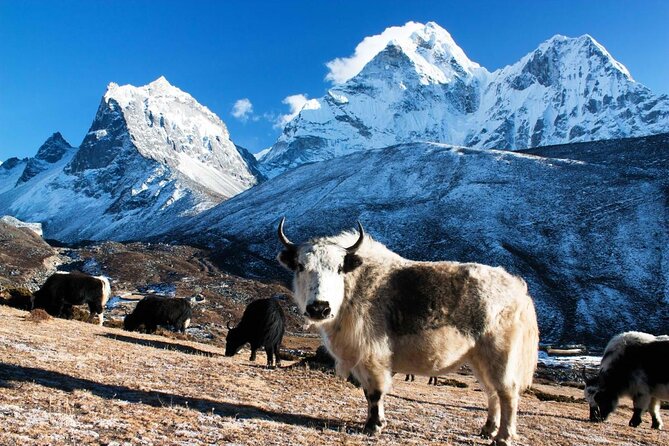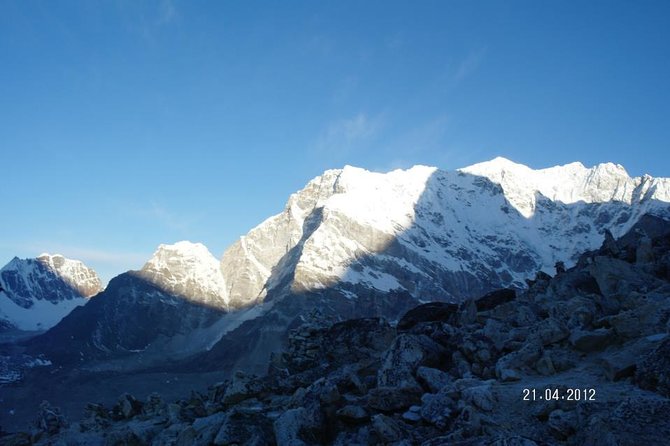Embarking on the Everest Base Camp trek is a once-in-a-lifetime opportunity to witness the sheer grandeur of the Himalayas. Trekkers can expect a meticulously planned 12-day journey through the Sagarmatha National Park, seeing the rich Sherpa culture and marveling at the snow-capped peaks that tower above. While the trek requires a moderate level of fitness to navigate the gradual ascent to an altitude of 5,550 meters, the breathtaking vistas and the feeling of accomplishment make the challenge well worth it. But what awaits those who dare to venture to the foot of the world’s highest mountain?
Key Points

- The 12-day Everest Base Camp trek offers trekkers the opportunity to admire the Himalayan peaks and enjoy Sherpa culture while hiking on well-established trails.
- The trek includes teahouse accommodation, meals, necessary permits, an experienced guide, and porters, ensuring a seamless and enjoyable trekking experience.
- Participants should have a moderate level of physical fitness, be able to hike 5-7 hours per day, and have the resilience to cope with potential altitude sickness.
- Highlights of the trek include stunning Himalayan vistas, visits to Sherpa villages and the iconic Tengboche Monastery, and reaching the dramatic Khumbu Glacier at the foot of Mount Everest.
- Proper planning and preparation, including obtaining necessary trekking permits and ensuring comprehensive travel insurance, are crucial for the successful completion of the Everest Base Camp trek.
It's also worth checking out some other tours and experiences nearby.
Overview of the Trek

The Everest Base Camp trek is a 12-day journey that takes trekkers to the foot of the world’s highest mountain, Mount Everest, located within the stunning Sagarmatha National Park.
Along the way, you’ll admire breathtaking views of the surrounding Himalayan peaks and learn about the rich Sherpa culture.
The trek follows well-established trails through picturesque villages, forests, and high-altitude landscapes.
Accommodation is in basic but comfortable teahouses, and most meals are included.
With an experienced, licensed guide and porters to assist you, you’ll be able to focus on enjoying the trek and soaking in the magnificent scenery.
This trek is best suited for fit travelers with some previous hiking experience.
Inclusion and Exclusions
This Everest Base Camp trekking package includes teahouse accommodation and most meals throughout the trek. It also covers all necessary permits, entry fees, and government taxes, as well as the services of an experienced, licensed trekking guide and porters to assist you.
The package also includes group medical supplies, Sagarmatha National Park fees, and a Trekker’s Information Management System (TIMS) card fee. However, it excludes international airfare, airport tax, and city tour sightseeing entry fees.
Travelers are responsible for obtaining a Nepal entry visa, as well as covering their personal expenses like laundry, telephone calls, snacks, and tips. Trekkers must also bring their own personal trekking gear and obtain travel insurance.
Logistics and Accommodation
Upon arrival, travelers are provided with airport/hotel/airport transfers by private vehicle as part of this Everest Base Camp trekking package. Comprehensive pre-departure information and trip dossiers are also included to help participants prepare for the journey.
During the trek, accommodation is in traditional Nepali teahouses, where meals are also provided. This allows trekkers to enjoy the local culture and lifestyle. The following table outlines the typical accommodation and meal arrangements:
| Accommodation | Meals |
|---|---|
| Teahouses | Breakfast, Lunch, Dinner |
| Camping | All meals prepared by trek staff |
| Hotels | Breakfast only |
This comprehensive logistics and accommodation support ensures a seamless and enjoyable Everest Base Camp trekking experience.
Fitness and Experience Level
Everest Base Camp trekking is best suited for fit travelers with prior hiking experience. Participants should have a moderate level of physical fitness to handle the demanding terrain and high-altitude conditions. A detailed packing list is provided to ensure trekkers have the necessary gear for the journey.
The trek requires:
-
Ability to hike for 5-7 hours per day, covering 6-12 km on uneven terrain.
-
Stamina to adjust to the gradual increase in altitude, with the highest point being Kala Patthar at 5,550 meters.
-
Resilience to cope with potential altitude sickness symptoms, such as headaches, fatigue, and shortness of breath.
-
Willingness to work as a team and support each other throughout the challenging trek.
Packing and Preparation
Proper preparation is essential for a successful Everest Base Camp trek, as trekkers must bring along a comprehensive set of essential gear and equipment to navigate the challenging high-altitude environment.
A detailed packing list is provided, which includes warm and layered clothing, sturdy and broken-in hiking boots, trekking poles, a sleeping bag rated for sub-zero temperatures, and a headlamp. Trekkers should also pack personal hygiene items, medications, and snacks for the trail.
It’s crucial to ensure all gear is in good condition before the trek. Plus, travelers should familiarize themselves with the local culture and customs to have a more meaningful experience.
With the right preparation, trekkers can fully enjoy the stunning beauty and rich heritage of the Everest region.
Highlights of the Trek
From the moment trekkers set foot on the trail, they’re captivated by the stunning vistas of towering Himalayan peaks, including the majestic Ama Dablam and Thamserku mountains.
Along the way, they’ll encounter vibrant Sherpa villages, where they can learn about the region’s rich cultural heritage.
The highlights of the trek include:
-
Visiting the iconic Tengboche Monastery, a Buddhist sanctuary perched on a hilltop with awe-inspiring views of the surrounding peaks.
-
Trekking through the rhododendron forests of Sagarmatha National Park, a UNESCO World Heritage Site teeming with diverse flora and fauna.
-
Reaching the dramatic Khumbu Glacier, a vast river of ice at the foot of Mount Everest.
-
Experiencing the warm hospitality of the Sherpa people and gaining insight into their way of life.
Sherpa Culture and History
As trekkers enjoy the magnificent landscapes, they also have the opportunity to gain insights into the vibrant Sherpa culture and its long-standing history along the trails. The Sherpa people are renowned for their expertise in high-altitude mountaineering and their deep reverence for the sacred peaks. Trekkers can explore Sherpa villages, visit monasteries, and learn about their rich Buddhist traditions, which are deeply intertwined with the local environment.
| Key Aspects of Sherpa Culture | |
|---|---|
| Religion | Buddhism |
| Language | Sherpa |
| Traditional Dress | Chuba, DzeRaja |
| Cuisine | Momos, Tongba |
This cultural exchange adds a meaningful dimension to the Everest Base Camp trek, allowing travelers to connect with the local community and gain a deeper appreciation for the region’s heritage.
Trekking Permits and Fees
Obtaining the necessary permits and paying the required fees are crucial steps in embarking on the Everest Base Camp trek.
Trekkers must obtain the following:
- Sagarmatha National Park Permit: This permit grants access to the park and is required for all trekkers.
- Trekkers’ Information Management System (TIMS) Card: This card provides the government with necessary information about the trekker and their trek.
- Nepal Entry Visa: All international visitors must obtain a Nepal entry visa prior to their trek.
Comprehensive travel insurance is highly recommended to cover any medical emergencies or trip disruptions.
These permits and fees ensure the proper management and regulation of the Everest Base Camp trek, contributing to the overall safety and sustainability of the experience.
Here's a few more nearby tours and experiences we think you'll like.
Frequently Asked Questions
Can I Charge My Devices During the Trek?
Yes, you can charge your devices during the trek. Most tea houses along the trekking route have power outlets available for guests to charge their electronics, though access may be limited at higher elevations.
What Is the Weather Like at Different Times of Year?
The weather at Everest Base Camp varies throughout the year. During the spring (March-May), days are sunny but nights are cold. Summers (June-August) bring warmer temperatures, while autumn (September-November) sees cooler days and freezing nights. Winters (December-February) are bitterly cold.
How Difficult Is the Trek in Terms of Altitude and Terrain?
The trek involves significant altitude gain, reaching over 17,500 feet. The terrain is challenging, with steep ascents, rocky trails, and potentially icy conditions. Trekkers must be physically fit and prepared for the rigors of high-altitude hiking.
What Happens if I Get Altitude Sickness During the Trek?
If a trekker develops altitude sickness, they should descend immediately to a lower elevation. The guide will monitor their condition and take appropriate actions, which may include administering oxygen or seeking further medical assistance if symptoms worsen.
Can I Buy Supplies Along the Trek if I Run Out?
Hikers can typically purchase supplies along the trek if they run out. However, the selection may be limited and more expensive compared to purchasing gear beforehand. It’s best to pack essential items to avoid running out on the trail.
Not for you? Here's more of our most recent tour reviews happening neaby
- Everest Base Camp Helicopter Tour With Sharing Flight
- Phulchoki Bird-Watching Tour
- Kathmandu UNESCO Heritage Tour
- Kanchenjunga Circuit Trek
- Annapurna Tilicho Lake Trek
- Kathmandu City Tour
- Traditional Kathmandu Day Tour With History and Mystery
- Everest Helicopter Tour- Day Tour
- Everest Base Camp Helicopter Tour
- 3-Day Guided Safari Tour in Chitwan National Park in Nepal
- Kathmandu Full-Day Private Tour With Pick up
- Nepali Cooking Class & Momo Making in Thamel With Pickup Option
- Kathmandu Heritage Tours (Kathmandu City Tour Full Day)
- Mardi Himal Yoga Trek
- 10 Days Annapurna Base Camp Trekking
Recap
The Everest Base Camp Trek offers trekkers a once-in-a-lifetime opportunity to enjoy the captivating Himalayan landscape and Sherpa culture.
With experienced guides, comfortable accommodations, and well-established trails, this 12-day journey to the base of the world’s highest mountain provides an unforgettable adventure for those with a moderate level of fitness and the ability to adapt to gradual increases in altitude.
